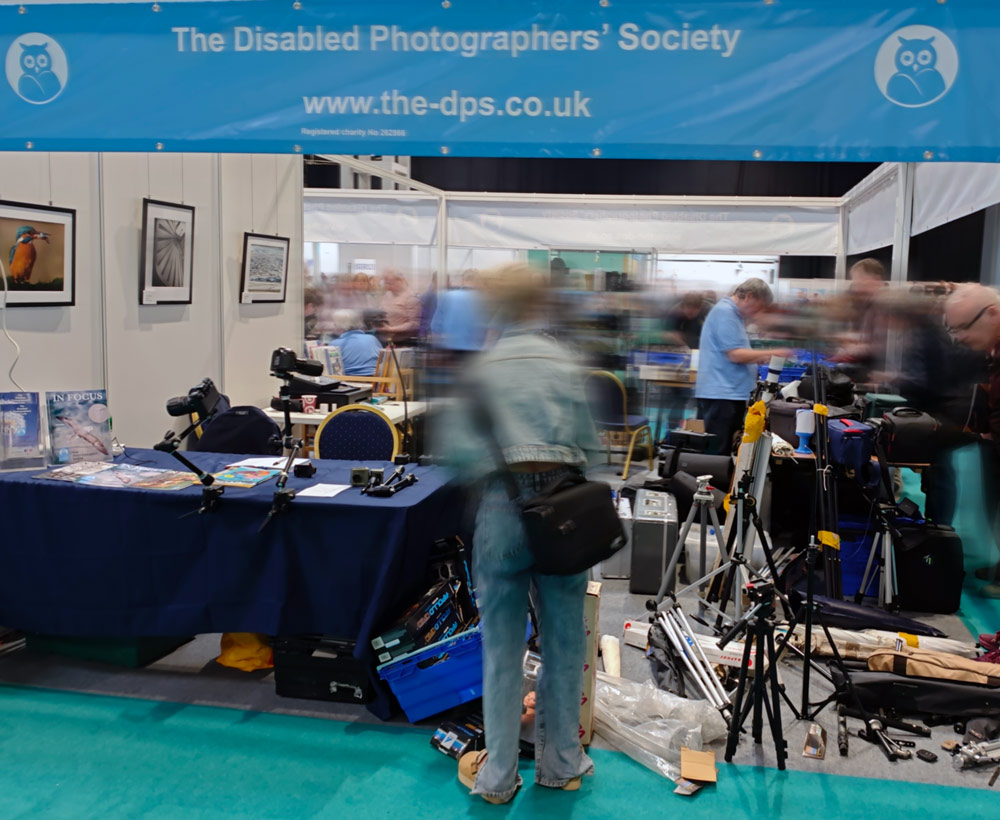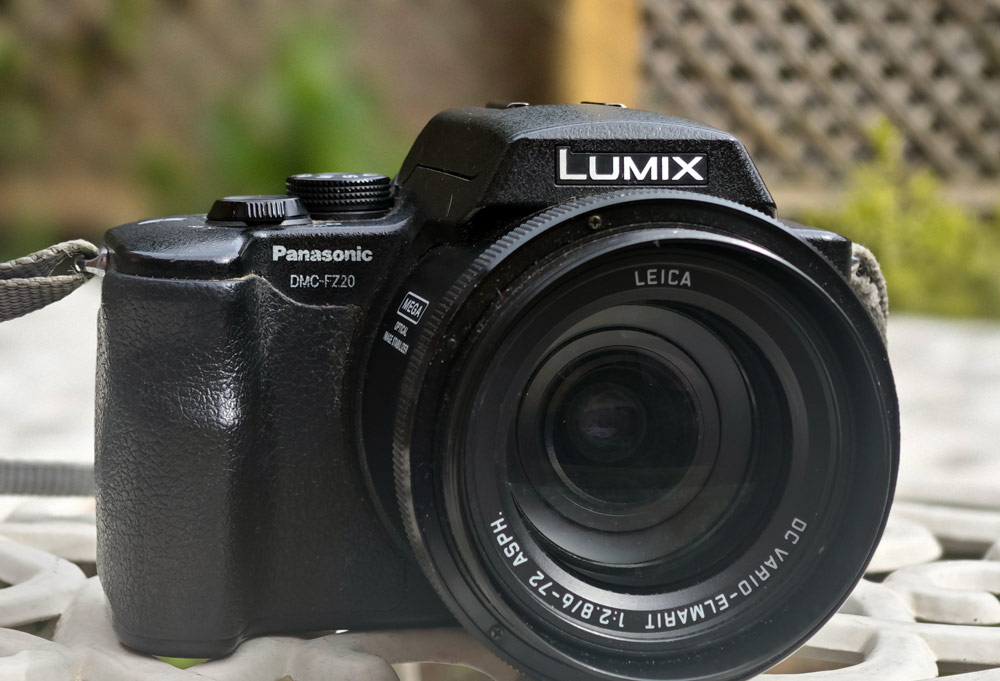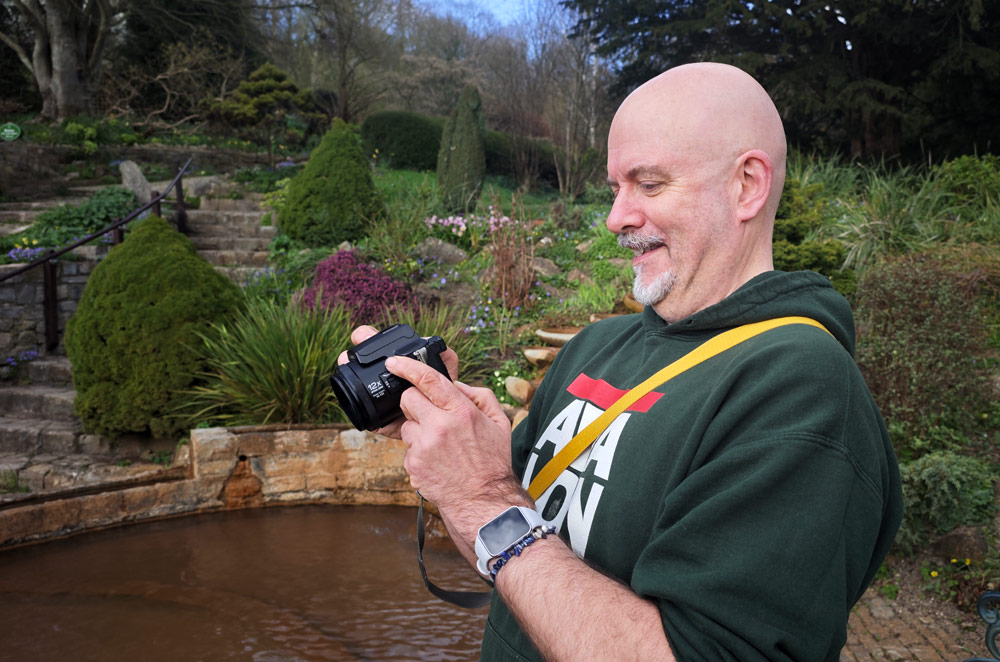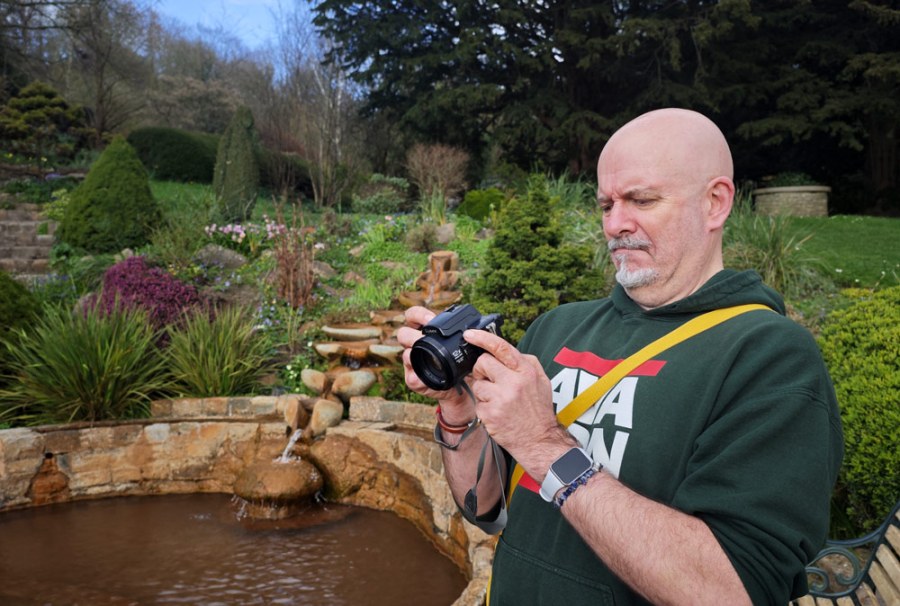We photographers have never had it so good, with such a wide choice of excellent mirrorless cameras, and some great used deals to be had on still very usable DSLRs.
So it’s ironic that there is something of a mini-boom in sales of old digital cameras, particularly colourful and bling compacts. By old I mean early to mid 2000s, and some models, such as the flashier-looking Nikon Coolpixes, are now commanding the kind of eBay prices that would have seemed ludicrous only a couple of years ago.
Panasonic Lumix DMC-FZ20 for pennies
Never one to shirk a challenge, I thought I would therefore have a go with a vintage Panasonic Lumix DMC-FZ20 superzoom, or bridge camera, which came out in 2004. Also known as the Panasonic Lumix FZ20 for brevity, I snaffled this camera for the princely sum of £5, from the ever-busy Disabled Photographers Society stand at the recent Photography and Video Show in Birmingham.
The DPS ‘jumble sale’ is a much-loved attraction of the show and is always three-deep with punters, so hats off to the patience and fortitude of the volunteers who run it (as well as the sterling work done by the society generally).

The Panasonic came with no guarantee that it even worked, but I figured it was worth a shot. What can you buy for £5 these days, anyway? A forgettable supermarket-sandwich meal deal? A pint if you’re careful, or a bag of chips? You can see why I took the risk. Heck, I even got a branded strap, though there was no charger.

We mentioned earlier how the more stylish vintage digital compacts are in big demand, but the Panasonic Lumix DMC-FZ20 will never be hailed a modern classic. It’s lumpy, black and drab, and not even the fancy crinkle finish can hide the fact that it’s just, well, plain.
Back in 2004 the camera was lauded for its SLR-a-like looks and while it’s relatively light at 556g and very grippable, this is not a retro device that will turn heads.
Panasonic Lumix DMC-FZ20 at a glance
- 5MP CCD sensor (max resolution: 2560 x 1920)
- Lens: 12x zoom, Leica Vario-Elmarit branded, optical image stabilsation
- Focal length (35mm equivalent): 36–432 mm
- Aperture range: f/2.8 to 8
- ISO range: 80-400
- AF: Contrast Detect, Single Live View
- Screen: 2 inches, 130,00 dots
- Image formats: standard JPEG, fine JPEG, TIFF
A quick glance at the above specifications shows how totally outgunned the Panasonic Lumix DMC-FZ20 is by today’s consumer cameras, not to mention smartphones, but sharp-eyed readers will have noticed two attractions that can still appeal.
First, that maximum 2.8 aperture extends throughout the comprehensive zoom range, and second, the Leica-branded lens is optically stabilised.
I got some new batteries to be on the safe side, and praise the lord, the camera still worked. I then nervously headed out to a local park. Ok, it worked, but had I been sold a pup for that precious fiver, after all?
Handling and usability
Getting to grips with the Panasonic Lumix FZ20 was pretty straightforward, though it reminded me how much better camera menu and interface design is now these days.
Yes, it has a useful PASM mode, but I still had to dive into the laughably dated looking menu more than I’d like, and here’s the real kicker: when in Manual or Semi-Automatic modes, you have to keep pressing a pointless Exposure button to adjust, you’ve guessed it, exposure.

This soon felt like an unnecessary extra step, or a proper pain in the backside to be more blunt, and more time spent with the camera was, sadly, not a healer.
In addition, the four way navigation pad is painfully small, and many was the time I accidentally adjusted the Timer or Flash settings when all I wanted to do was to stop up or down. It’s ok if you have very dainty fingers, but, really… The image preview button sits awkwardly at the bottom of the rear dial, too.

So even after making allowances for the camera’s age, much of the rear design and layout sucks. You do get used to it however, and things get better on the top of the camera: the PASM dial is nice and chunky and a handy lever facilitates zooming in and out.
The Electronic Viewfinder, meanwhile, is small and murky by today’s standards, and again, diopter adjustment requires a pixie’s fingers. While the EVF is certainly useable, you can see why most DSLR users were sticking with their lovely optical viewfinders at the time.
Does the Panasonic Lumix DMC-FZ20 still take decent photos?
So, I can live with the klutzy handling and ho-hum design considering I paid chump change, but here’s the million dollar question for my £5 camera. Can the Panasonic Lumix FZ20 still take good photos? Well… yes.
I chose to shoot in fine JPEG mode rather than messing about with TIFF – there is no raw option – and generally the results ranged from not too bad to surprisingly good, given the cameras age.

A big reason for this is that relatively bright, fast lens, and being able to open up to f/2.8 throughout the zoom range was a real bonus. As is the image stabilisation – there is a choice of mode 1 or 2, and I found mode 2 worked well most of the time.
Even with OIS, however, you need to hold this camera quite firmly at slower shutter speeds and compared to modern image stabilisation systems, it only feels competent at best. It’s definitely better than nothing considering how far the lens zooms out, however.

The dynamic range is OK considering the Lilliputian sensor, though I did notice a strong tendency to blow highlights in daylight, particularly when shooting in P or Auto modes. If I was to use this camera more regularly, I’d definitely want to adjust for this. There is also noticeable red fringing when shooting at full zoom or wide apertures, but no worse than you’d get with other bridge cameras of the Panasonic’s era.

The autofocus is also limited, though it’s fine for static for slow moving subjects in decent light. There is some focus hunting in poorer light or when the lens is zoomed out, but it’s acceptable.

A bigger problem for me was the slow card-write speeds, though that was made much worse by using the rubbish 1GB SD card that came with the camera. After putting in a modern card, the write performance got faster, though this camera wouldn’t be your first choice or action and sports, even, I suspect, back in its glory days of 2004.

Switching to manual focus is very easy, thanks to a slider on the side of the lens, with basic focussing aids available. This is a good way of making the most of that still-respectable glass, as the 20-year-old AF definitely has its limitations.

With regards to ISO you can only go as far as 400, so noise very quickly rears its ugly head, even starting at ISO 200 – though this is nuisance is definitely offset by the benefits of the fast, bright lens.

In decent light, you can get decent results, so long as you don’t pixel peep too much post-shoot. As for video, it’s very rudimentary: you can record at 320×240 resolution in mJPEG format (remember that?). You get a mono microphone, too.

So was my fiver well spent?
In conclusion, definitely. At times the Panasonic Lumix DMC-FZ20 can be charmingly retro, at other times, downright infuriating, but considering how little I paid for the camera, it is definitely a keeper. That stabilised, fast lens and good zoom range can still deliver the goods, so it was worth buying just for these.

While I will never grow to love the camera’s handling or basic AF capabilities, this does slow you down (in a good way) and get you more mindful about how you frame and shoot. Furthermore, the shutter and zoom lens mechanism are impressively quiet, so it’s quite a good camera for discreet street photography.
Unless a burglar clears me out, I can’t ever see this bargain-bucket Panasonic DMC-FZ20 becoming my ‘main’ camera, or even my main back-up. Most of the time I have my phone on me – the Xiaomi 14, which produces very good images – but I’ll definitely keep the Panasonic in the car in case I leave said phone at home or it runs out of battery.
It would also be fine to give to a friend or relative who’s starting out in photography, to help them learn the basics of the exposure triangle, for example.

So, the Panasonic Lumix FZ20 is far from being a bad buy for a fiver, and a reminder that a 20-year-old superzoom compact shouldn’t be instantly dismissed as a dated dog.
Its relative bulk and meat-and-potatoes design mean that the value is unlikely to rise much, vintage digital camera boom or not, but considering the Panasonic Lumix DMC-FZ20 currently goes for about £30 on eBay, I’d even say it was a steal – particularly as my purchase helps support the Disabled Photographers Society (the same goes for any charity-related shop you buy one or something similar from).
Further reading
Best used bridge cameras in 2024
It’s official: older digital compacts are back in fashion
Vintage digital cameras you should actually buy








